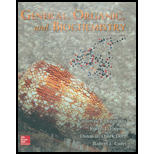
Concept explainers
(a)
Interpretation:
The reason why water is a good solvent for magnesium chloride has to be explained.
(a)
Explanation of Solution
Magnesium chloride is an ionic compound containing positively charged magnesium ions and negatively charged chloride ions bonded through electro static interaction. Water is also a polar compound due to the difference in electro negativities of oxygen and hydrogen. So according to the rule “like dissolves like” polar magnesium chloride dissolves in polar water.
(b)
Interpretation:
The
Concept Introduction:
The
(b)
Answer to Problem 1MCP
The
Explanation of Solution
The
Percent mass/volume is
(c)
The
Concept Introduction:
The
(c)
Answer to Problem 1MCP
The
Explanation of Solution
The mass of solution can be calculated using the given volume of solution
The
Percent mass/mass is
(d)
Interpretation:
Number of moles of magnesium chloride in the solution has to be calculated.
Concept introduction:
Number of moles can be calculated as follows,
(d)
Answer to Problem 1MCP
Number of moles of
Explanation of Solution
Molar mass of
Number of moles of
Number of mole is
(e)
Interpretation:
The molarity of
Concept Introduction:
Molarity can be calculated using following equation.
(e)
Answer to Problem 1MCP
The molarity of
Explanation of Solution
Number of moles of
The molarity of
Molarity is
(f)
Interpretation:
The given magnesium chloride solution is an electrolyte or not has to be predicted.
(f)
Explanation of Solution
The given magnesium chloride solution is an electrolyte, because when dissolved in water it dissociates to form positive charged magnesium ion and negatively charged chloride ions.
(g)
Interpretation:
The boiling point of the given magnesium chloride solution has to be compared with the boiling point of water.
(g)
Explanation of Solution
The boiling point of the given magnesium chloride solution will be greater than that of pure water, because boiling point is the temperature at which vapor pressure becomes equal to atmospheric pressure. If a non volatile solute (magnesium chloride) is added then the vapor pressure get lowered. So, more temperature has to be provided for vaporizing. Hence the boiling point increases.
(h)
Interpretation:
The melting point of the given magnesium chloride solution has to be compared with the melting point of water.
Concept Introduction:
(h)
Explanation of Solution
The melting point of the given magnesium chloride solution is lower than that of pure water, because at freezing point solid phase of the solvent will be in equilibrium with liquid phase. When solute molecule (magnesium chloride) is added, it will interfere with the rate at which the liquid molecules associate to form solid state, hence lower the freezing point of the solution.
Want to see more full solutions like this?
Chapter 6 Solutions
GENERAL,ORGANIC,+BIOCHEM.(LL) >CUSTOM<
 ChemistryChemistryISBN:9781305957404Author:Steven S. Zumdahl, Susan A. Zumdahl, Donald J. DeCostePublisher:Cengage Learning
ChemistryChemistryISBN:9781305957404Author:Steven S. Zumdahl, Susan A. Zumdahl, Donald J. DeCostePublisher:Cengage Learning ChemistryChemistryISBN:9781259911156Author:Raymond Chang Dr., Jason Overby ProfessorPublisher:McGraw-Hill Education
ChemistryChemistryISBN:9781259911156Author:Raymond Chang Dr., Jason Overby ProfessorPublisher:McGraw-Hill Education Principles of Instrumental AnalysisChemistryISBN:9781305577213Author:Douglas A. Skoog, F. James Holler, Stanley R. CrouchPublisher:Cengage Learning
Principles of Instrumental AnalysisChemistryISBN:9781305577213Author:Douglas A. Skoog, F. James Holler, Stanley R. CrouchPublisher:Cengage Learning Organic ChemistryChemistryISBN:9780078021558Author:Janice Gorzynski Smith Dr.Publisher:McGraw-Hill Education
Organic ChemistryChemistryISBN:9780078021558Author:Janice Gorzynski Smith Dr.Publisher:McGraw-Hill Education Chemistry: Principles and ReactionsChemistryISBN:9781305079373Author:William L. Masterton, Cecile N. HurleyPublisher:Cengage Learning
Chemistry: Principles and ReactionsChemistryISBN:9781305079373Author:William L. Masterton, Cecile N. HurleyPublisher:Cengage Learning Elementary Principles of Chemical Processes, Bind...ChemistryISBN:9781118431221Author:Richard M. Felder, Ronald W. Rousseau, Lisa G. BullardPublisher:WILEY
Elementary Principles of Chemical Processes, Bind...ChemistryISBN:9781118431221Author:Richard M. Felder, Ronald W. Rousseau, Lisa G. BullardPublisher:WILEY





